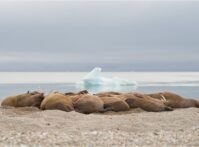-
ECSP Weekly Watch: March 4 – 8
March 8, 2024 By Eleanor Greenbaum
A window into what we are reading at the Wilson Center’s Environmental Change and Security Program
Climate Change Disproportionately Impacts Rural Women (U.N. Food and Agriculture Organization)
A recent report by the U.N. Food and Agriculture Organization analyzed data from 24 low- and middle- income countries (LMICs) across five regions and over 100 thousand rural households to measure the impacts of climate change on rural women, youth, and people living in poverty. It found that climate change’s impacts disproportionately impact households headed by women, with income losses due to extreme heat (8% income loss) and flooding (3% income loss), relative to households led by men. The income gap between men and women was also widened as a result.
This new analysis also highlighted the specific challenges faced by impoverished households, particularly women living in poverty. Poor households lose 5% of income from heat stress and 4.4% from floods relative to better-off households. These stressors also widened the income gap between poor and wealthy households. Similar impacts also were noted in households headed by young people. Yet, despite the clear disproportionate impact climate has on women, impoverished households, and youth, climate finance does not sufficiently reach these communities.
The report offers several recommendations for multifaceted programming to address these multidimensional challenges. Taking the specific needs of communities disproportionately affected by climate change is essential. The FAO specifically recommends includes collection of disaggregated data, increased efforts for women’s economic empowerment, and increased technical education for climate-smart economic activities.
LISTEN | The Arc | Gender, Agriculture, and Climate Change with Dr. Maureen Miruka
NOAA Warns of a Fourth Mass Coral Bleaching Event (Reuters)
The U.S. National Oceanic and Atmospheric Administration (NOAA) says that the world is on the verge of a fourth mass coral bleaching event following months of record-breaking heat. Coral bleaching occurs when corals expel algae from their tissues as a result of extreme temperatures. This harms the ocean ecosystem, fisheries, and tourism-based industries: all of which rely on corals for their survival.
The last massive bleaching event occurred between 2014 and 2017, when the Great Barrier Reef lost a third of its corals. (The two events prior to that happened in 2010 and 1998.) While this most recent event is linked to El Niño, which causes warmer ocean temperatures, increased global temperatures overall will likely cause coral bleaching at an increased rate. Scientists have warned that a rise of 1.5C past pre-industrial levels would be a tipping point for coral reef die-off.
Australia’s Great Barrier Reef has been among the most greatly impacted areas by this event. Scientists are conducting “flyovers” of the reef to examine extent of bleaching. American Samoa has also experienced high levels of bleaching, and the Caribbean registered its worst bleaching on record last year. Yet to merit distinction as a “global mass bleaching event,” scientists must find bleaching from the Atlantic, Pacific, and Indian Oceans collectively. Scientists are awaiting confirmation from the Indian Ocean of a bleaching event.
READ | Our Ocean and Cryosphere Under Threat
Nomads Struggle in Mongolia’s Extreme Cold (Yale Environment 360)
An extreme weather event known as a “dzud”, which combines extremely cold temperatures with high rates of snowfall and high speed winds, is currently plaguing Mongolia. This phenomenon is not new one. Though it used to occur once per decade, a dzud has occurred there in 6 of the last 10 years. Fully 90% of the nation is at high risk from the deadly combination, and 2.1 million animals have died and nine people have been killed from snowstorms.
Approximately 1 million Nomadic herders rely on livestock for their food, fuel, and hides and wool—all of which supply their personal wellbeing and economic livelihoods. Thus, they place a high value on their animals. Many of them have died searching for lost livestock. However, the reliance on livestock has also resulted in overgrazing, which worsens both the summer drought and winter dzuds.
Climate change has not only impacted the frequency of dzuds, but also their intensity. Winter snow has grown 40% since 1961 ,and extreme cold has increased there by 28% more between 2000-2016 when compared to readings taken from 1981 through 1999. This impact also has been exacerbated by summer droughts, which also are increasing in frequency and intensity, and limit the amount of fat which animals can store and preventing stockpiling. While the UN and national government both have attempted to curtail the impacts with aid, long-term adaptation strategies remain lacking.
READ | In Mongolia, Climate Change and Mining Boom Threaten National Identity
Sources: UN Food and Agriculture Organization, Reuters, Yale Education 360
 A Publication of the Stimson Center.
A Publication of the Stimson Center.







